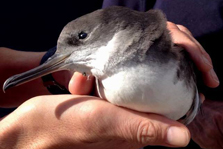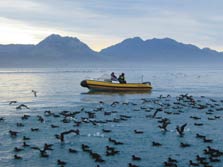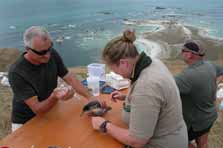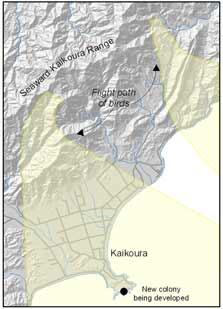New Zealand status: Endemic
Conservation status: Nationally Vulnerable
Threats: Predation
Species information: Hutton's shearwater/Kaikōura tītī on NZ Birds Online
Sound recording:
Hutton's shearwater/tītī song (MP3, 485K)
00:30 – Calling at burrow entrance.
Our bird songs can be reused, even commercially, according to our copyright terms.
Emergency hotline
Call 0800 DOC HOT (0800 362 468) immediately if you see anyone catching, harming or killing native wildlife.
Population decline
From an estimated population numbering millions of birds, introduced mammals and changes in land use have decreased the Hutton’s shearwater (Puffinus huttoni) population to less than half a million.
There is an estimated breeding population of more than 100,000 breeding pairs, with a similar number of non-breeding birds visiting colonies early in the breeding season.
Despite the relatively high number of birds, the species is regarded as nationally vulnerable because of past declines (evident from extinct colonies) and the threats still faced.
History
The Hutton's shearwater/tītī was long known to Māori, providing a major sustainable source of protein to Ngāti Kuri. Chicks were harvested from their burrows shortly before fledging and preserved in pōhā/kelp bags.
The Hutton’s shearwater was first officially described in 1912, and later there were anecdotal reports from highcountry farmers, hunters and various others of 'muttonbird' burrows at high elevations in the Seaward Kaikōura Range, behind Kaikōura. In 1965, following on from these leads, Geoff Harrow found carcasses in the headwaters of the Kowhai River at altitudes between 1,200 and 1,800 m above sea level, that were confirmed as Hutton's shearwaters.
Extensive searching led to the confirmation of eight colonies, but only two remnant colonies remain today. At least ten colonies formerly existed in both the Seaward Kaikōura and Inland Kaikōura Ranges; there is questionable evidence that the species may have bred beyond these mountains.
Where they're found

Hutton's shearwater
The distribution of Hutton’s shearwaters within New Zealand waters is poorly understood as few at-sea observers attempt to distinguish Hutton’s shearwaters from the similar fluttering shearwater. There are sightings and beach-wrecked birds from Northland to Foveaux Strait, including East Cape and Westland, though it is apparent that the bulk of the population stays between Cape Campbell and Banks Peninsula, off the north-east coast of the South Island, when breeding.
During the breeding season (August to March), Hutton’s shearwaters are present over the inshore coastal waters off Kaikōura. They fly low over the water and congregate in large flocks (rafts) before their evening flights to the mountain colonies.
Nesting occurs at the two remaining colonies in the Seaward Kaikōura Range, on steep tussock-covered slopes above 1,200 m altitude. The colonies are located in the Kowhai River catchment in Uerau Nature Reserve; and at Shearwater Stream in Puhi Peaks Nature Reserve (private property and QEII covenant).
Outside the breeding season Hutton’s shearwaters are migratory and most are absent from New Zealand waters. Adults fitted with geo-locators revealed details of their winter migration to Australia, where birds spend the non-breeding season feeding in warm fish-rich coastal waters, never making landfall.
Breeding

Hutton's shearwater spend most days at sea feeding on small fish and krill

Hutton's shearwater chick covered in down prior to gaining adult plumage
The Hutton’s shearwater is one of the few New Zealand seabirds to solely breed on the mainland. Birds arrive at their alpine colonies from late August onwards, then spend two months competing for burrows and mates. Burrow densities vary within sub-colonies, and the average burrow is 3 metres long.
Each pair produces a single egg each year. The peak of egg-laying is in early November. The 50 day incubation period is shared by both sexes, with a nestling period of 75-94 days. Hutton’s shearwaters have a longer chick-rearing period than other Puffinus species, this may be due to difficulties in obtaining sufficient food or the energetic costs associated with a colony 1,200 m above sea level.
Each day adults travel approximately 20 km to sea, to feed on fish and krill which are later fed to their chick. On their downhill flight they travel at up to 154 km/h, reaching the ocean in as little as seven minutes. The return trip takes around 38 minutes, with 1,200 m or more in altitude to be gained with a belly full of fish.
Upon fledgling (mid-March to early April) chicks migrate with other Hutton’s shearwaters to the fish-rich coastal waters off Australia. Immature birds remain there until returning to Kaikōura to breed at 3-4 years of age.
Threats

Hutton's shearwater killed by a stoat
Habitat loss and predation by introduced mammals is the main threat to remaining Hutton’s shearwater populations. Feral pigs are considered a major threat, being responsible for the loss of colonies in the last 100 years. Deer and chamois are known to trample nesting burrows, while stoats and cats will eat young birds and eggs.
Both of the remaining breeding colonies are confined to a small area, making the birds extremely vulnerable to events such as landslides or predation which could lead to extinction.
Conservation

Feeding a Hutton's shearwater chick that has been translocated to the Kaikoura Peninsula

Hutton's shearwater flight path (JPG, 46K)
A third colony (Te Rae o Atiu) was established on the Kaikōura Peninsula in 2005, to ensure long-term survival of the species. This was a joint project by Te Rūnanga o Kaikōura, Whale Watch Kaikōura and DOC, with support from Forest & Bird and the local community.
A predator-proof fence was then constructed by the Hutton’s Shearwater Charitable Trust in 2010. Multiple translocations occurred, with chicks transferred from mountain burrows to artificial burrows at the new colony. Volunteers hand fed chicks for a 2-3 week period, until they fledged. During this time the chicks ‘imprinted’ on the site, ensuring they would return to the new colony to breed. Chicks raised there are already returning and producing their own offspring. Over 40 pairs now breed at Te Rae o Atiu annually.
A 7.8 magnitude earthquake near Kaikōura on 14 November 2016 impacted Hutton’s shearwater greatly. The earthquake struck at the peak of laying and at around midnight, meaning that burrows with breeding birds that collapsed or were buried by landslides would have resulted in the loss of an egg and at least one adult. A minimum of 40,000 breeding Hutton’s shearwaters were lost in landslides and potentially another 80,000 from burrow collapse.
You can help
Hutton’s shearwater feed on fish, so are vulnerable to becoming tangled in set nets and drowning. Fishers can help protect the seabirds by monitoring set nets closely.
Like many nocturnal seabirds, young Hutton’s shearwaters become disoriented by bright lights when they fledge from their mountain colonies and fly to sea from mid-March to early April. Many crash land around the Kaikōura township during overcast weather, becoming stranded on the ground. The Hutton’s Shearwater Charitable Trust and DOC rely heavily on volunteers to assist in collecting crash landed birds for release.
Kaikōura residents and others can help to reduce the loss of young birds from mid-March to early April by:
- turning off any non-essential outside lights
- directing light sources downwards with hoods or covers
- closing curtains at night
- driving carefully to avoid hitting crash landed birds on roads
- keeping dogs and cats contained or indoors at night to prevent predation
- taking crash landed Hutton’s shearwaters to the Kaikōura DOC office, to ensure release at an appropriate site.
